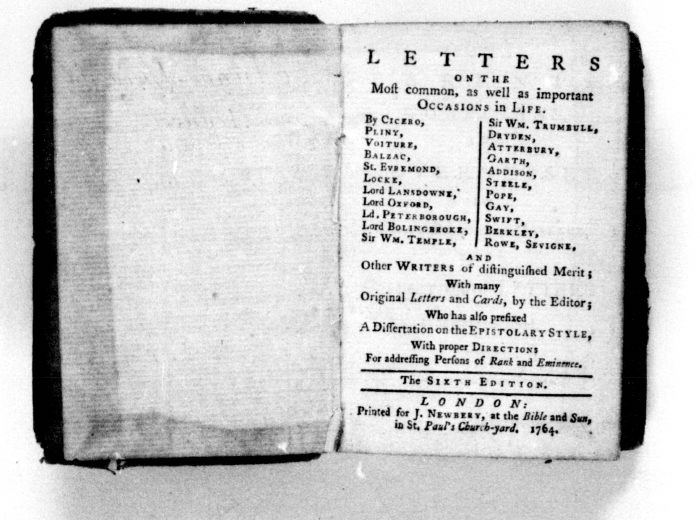Books of Instruction. 0603: Anon. (John Newbery?), Letters on the Most Common, as well as Important Occasions in Life
| Author: |
Anon. (Newbery, John?) |
| Title: |
Letters on the most common, as well as important occasions in life. By Cicero, Pliny, Voltaire, Balzac, St. Evremond, Locke, Lord Lansdowne, Lord Oxford, Lord Peterborough, Lord Bolingbroke, Sir William Temple, Sir William Trumbull, Dryden, Atterbury, Garth, Addison, Steele, Pope, Gay, Swift, Berkley, Rowe, Sevigne, and other writers of distinguished merit; with many original letters and cards, by the editor; who has also prefixed a dissertation on the epistolary style, with proper directions for addressing persons of rank and eminence. The sixth edition |
| Cat. Number: |
0603 |
| Date: |
1764 |
| 1st Edition: |
1756 |
| Pub. Place: |
London |
| Publisher: |
J. Newbery, at the Bible and Sun, in St. Paul's Church-Yard, 1764 |
| Price: |
|
| Pages: |
1 vol., 370pp. |
| Size: |
10 x 6.5 cm |
| Illustrations: |
None |
| Note: |
Inscription on front end paper: 'Anna Theodosia Jephcott' |
Images of all pages of this book

Introductory essay
It is the dedication to parents, guardians and governesses, signed 'John Newbery', which has given rise to the idea that Newbery wrote, as well as published, this work. Sydney Roscoe, Newbery's bibliographer, neither confirms nor denies this. He does note that seven or more editions of the work appeared within eleven years, of which the Hockliffe Collection has the sixth, testifying to the work's popularity. After 1767, no further editions appeared until 1786, when Newbery's successor, Thomas Carnan, republished the book (with a further edition in 1787). In the lacuna between Newbery's and Carnan's editions, Francis Newbery, John's nephew, apparently brought out a rival title, bearing a slightly different name but imitating the original: The Tutor; or Epistolary Guide. Being a Collection of Familiar Letters on the Common Occurrences of Life (Roscoe 1973: 198-200 and 264).
John Newbery's book divides into two unequal sections. First comes a thirty-page section called 'Instructions for epistolary writing'. It discusses the importance of letter-writing, and offers general advice on how to address various correspondents and how to write efficient, interesting and, above all, polite letters. Following this are 340 pages of the letters of eminent literary figures. They were there for readers to emulate, but a they must also have offered entertainment in their own right. Newbery's book, then, was surely intended and received both as a didactic and entertaining work.
Roscoe, Sydney, John Newbery and his Successors, 1740-1814: A Bibliography, Wormsley, Herts., 1973



